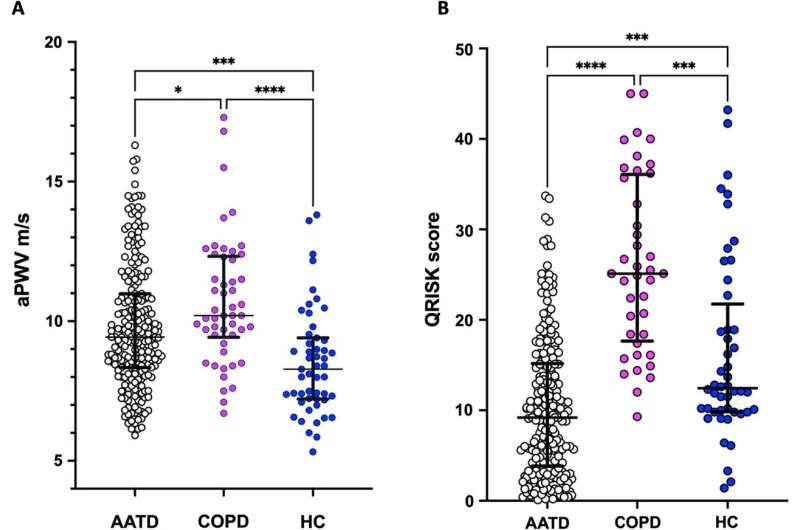This article has been reviewed according to Science X's editorial process and policies. Editors have highlighted the following attributes while ensuring the content's credibility:
fact-checked
trusted source
proofread
Lung disease puts patients at risk of developing heart conditions regardless of other risk factors

Patients with lung disease are more likely to develop heart disease independent of any risk factors, according to new research.
A new study published in Orphanet Journal of Rare Diseases looked at patients who have a rare genetic condition called Alpha-1 antitrypsin deficiency (AATD) which causes lung disease similar to COPD independently of any risk factors such as smoking or age.
More than 220 patients with AATD were recruited to the study alongside patients with COPD and a control nonlung disease population, and all were assessed for present cardiovascular disease (CVD) and recognized risk factors, including assessment of vascular stiffness known to increase the risk for future events. Patients were then tracked for four years to see whether they developed CVD.
The patients with the rare genetic condition AATD had the highest adjusted scores among all participants for vascular stiffness but had the lowest scores for the standard associated risk factors of CVD, and nearly half (45%) of patients had discordant scores where one was high and the other low.
Meanwhile, COPD and control participants had similar scores across the direct and indirect measures of CVD risk.
Furthermore, despite the AATD participants having lower risk factors associated with developing cardiovascular disease, including being younger and a higher proportion who had never smoked, 12.7% of participants developed CVD after four years of follow-up.
Robert Stockley, Professor and Consultant in Acute and Respiratory Medicine at the University of Birmingham and senior author of the paper, said,
"This long-term study has enabled us to see the relationship between lung disease and heart disease in a unique way by following a group of patients with this rare genetic disease.:
"Our study has shown that there is an increased risk for people with lung conditions of going on to develop cardiovascular conditions and that only looking at conventional factors such as age and smoking doesn't give the full picture of the relationship between these two essential systems in the body."
Potential target for treatment
Participants also gave blood, which was tested for an enzyme linked with lung damage in AATD patients.
There were significantly higher levels of the enzyme Proteinase 3 in the AATD patients, but the study found that there was a link between elevated levels of the enzyme and vascular stiffness and, hence, CVD risk.
The team believes that the Proteinase 3 enzyme may have a more direct impact on the development of heart and lung disease through the breakdown of fibers that support the large arteries and lungs and that Proteinase 3 inhibitors could be a novel therapeutic to prevent cardiovascular disease, especially in AATD patients.
Louise Crowley, Clinical Research Fellow and Ph.D. researcher at the University of Birmingham and corresponding author of the paper, said,
"The role of Proteinase 3 acts as a powerful link between lung and heart disease. The action that the enzyme has in attacking elastin fibers found in the lungs and major arteries suggests that inhibiting its action could have a dual effect to slow both lung and cardiovascular diseases."
More information: E. Sapey et al, Cardiovascular disease in Alpha 1 antitrypsin deficiency: an observational study assessing the role of neutrophil proteinase activity and the suitability of validated screening tools, Orphanet Journal of Rare Diseases (2024). DOI: 10.1186/s13023-024-03124-x





















